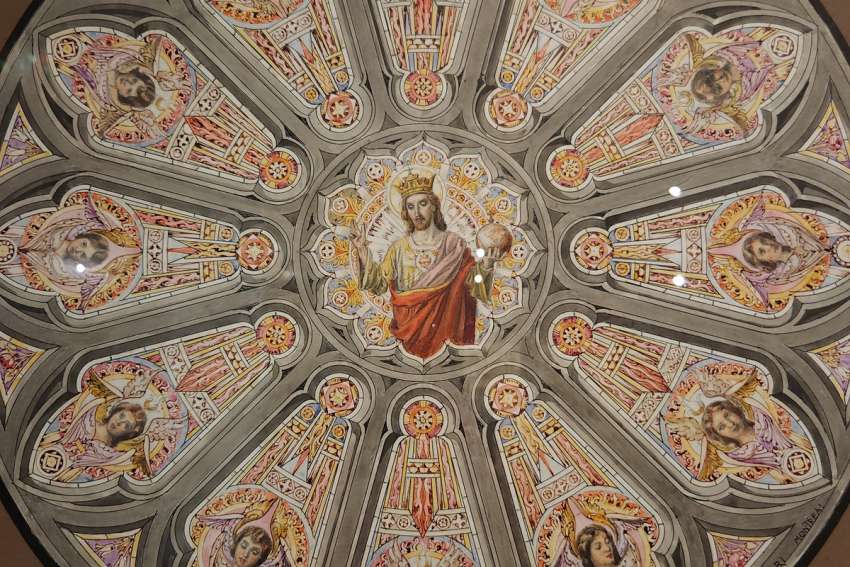Nincheri is best known for his remarkable contribution to 20th-century ecclesiastical aesthetics, but the exhibit, entitled From the Secular to the Sacred, is housed in the only extant site of his secular work in a domestic setting.
The windows of the grand living room of the Château Dufresne now look out on Montreal’s hyper-modernist Olympic Stadium, but when the mansion was constructed and decorated for Oscar and Marius Dufresne in the first half of the 20th century (the entire project took close to 35 years to complete), it was the romantic Beaux-Arts style that was in fashion.
Nincheri was commissioned by the businessman brothers to bring his Italianate training and taste to the wall-paintings and stained glass of their new home.
Visitors to the exhibit first walk through the rooms where Nincheri was allowed, in his words, “to let my fantasy and my imagination run free, to draw from poetry and human beauty.”
The subject matter of the wall paintings are Greek myths, the stories of Pysche and Cupid and Orpheus and Eurydice, and the many paintings of nubile nudes might come as a surprise for anyone familiar with either Quebec history or with Nincheri’s religious work.
Trained at the Academy of Fine Arts of Florence during the height of the Art Nouveau and Purismo movements, Nincheri arrived in Montreal with his bride Giulia in 1913 with little money but in the middle of a huge immigration surge in Canada. That influx of European Catholics, as well as a healthy fertility rate in Quebec, resulted in a church-building boom.
Nincheri’s work ended up in more than 220 churches in North America, with about 40 per cent of those projects in Quebec. His work can be found throughout the northeast including Prince Edward Island, Rhode Island and Toronto.
Pastors tasked with being general contractors for these building projects were able to turn to Studio Nincheri, established in 1925, as a one-stop shop for their church interior decoration.
In two ground floor rooms of the Château Dufresne, the exhibit displays about 40 drawings and documents related to the management of the Studio. The carefully rendered pen and ink drawings of proposed stained-glass windows and frescos as well as the logs of contracts and business letters between the Studio and parish priests, written out in equally meticulous penmanship, demonstrate the attention to detail and work ethic that exemplified Nincheri and his team.
There are several finely drawn sketches for the more famous stained-glass windows executed by Nincheri, including the rose window of St. Patrick’s Basilica in Ottawa that depicts Christ the King centred in a corona of 12 angels.
There is also an exquisite rendering of the cupola of St. Michael the Archangel Church, built for the Irish community of Mile End.
The exhibit includes a pencil and watercolour sketch for the now infamous fresco of Mussolini seated on horseback located in the Montreal church of Notre-dame-de-la-defense. A plaque alongside the sketch notes that the inclusion of the image of Mussolini was not due to fascist tendencies in Nincheri but to pressure applied by Senator Lawrence Wilson, who wanted to mark Mussolini’s role in the 1929 Lateran Treaties. Despite this, Nincheri was arrested in 1940 and spent three months interred at Petawawa along with other Italian Canadians so interred during the Second World War.
The plaque notes, “with the help of influential clergy members, his wife Giulia managed to prove that the Italian dictator was not part of the initial layout signed by the artist.”
Author Mélanie Grondin in her 2018 book The Art and Passion of Guido Nincheri speaks of the relative oblivion of Nincheri’s reputation. She explains this obscurity as a casualty of Nincheri’s subject matter.
“These days, few people in Quebec are interested in religious matters,” Grondin writes.
The exhibit opens a window to a time when, despite economic hardship and war, “religious matters” provided the energy and drive for a remarkable corpus of artistic output.
Nincheri: From the Secular to the Sacred is on at Museum Château Dufresne until June 30.


